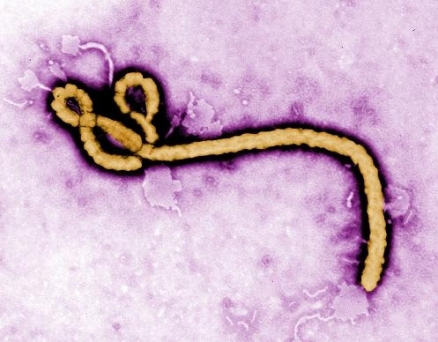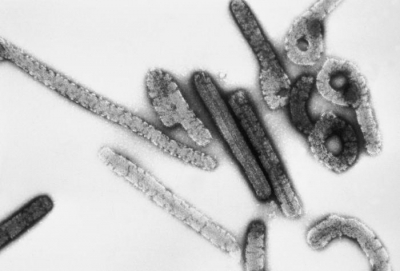Ebola and Marburg hemorrhagic fevers
Ebola and Marburg hemorrhagic fevers are acute viral diseases that lead often to severe illness and death in humans and other primates. The infections typically affect multiple organs in the body and are often accompanied by hemorrhage (bleeding). Once the virus has been transmitted from an animal host to a human, it can then spread through person-to-person contact.
Contents
Ebola/Marburg
Overview
Ebola and Marburg hemorrhagic fevers are acute diseases that often lead to severe illness and death in both humans and nonhuman primates. The diseases typically affect multiple organs in the body and are often accompanied by hemorrhage (bleeding). The illnesses are caused by filoviruses, the only two known members of the virus family Filoviridae.
Marburg hemorrhagic fever was first recognized in 1967, when laboratory workers in Germany and Yugoslavia developed a hemorrhagic illness after handling tissue from green monkeys. The outbreak resulted in 31 infections and 7 deaths. Researchers later identified the cause as a never-before-seen filovirus, termed “Marburg” after one of the outbreak locations.
Eleven years later, Ebola virus was identified when two outbreaks of hemorrhagic fever occurred in northern Zaire (now the Democratic Republic of Congo) and southern Sudan. The causes of the outbreaks were identified as two different species of another novel filovirus, called “Ebola” after a river in northern Zaire. Both species proved to be highly lethal, as 90 percent of the Zairian cases and 50 percent of the Sudanese cases resulted in death.
Cause
There arefive species of Ebola virus, named for the locations in which they were first recognized. Four of thefive subtypes have caused disease in humans: Ebola-Zaire, Ebola-Sudan/Gulu, Ebola-Ivory Coast, and Ebola-Bundibugyo. The fifth, Ebola-Reston, has caused disease in nonhuman primates (gorillas, chimpanzees, and monkeys) but not in humans.
Transmission
Filoviruses are believed to be zoonotic, meaning they are transmitted to humans by animals. The natural reservoirs, or animal hosts, of Ebola and Marburg viruses are not known. The viruses can replicate, or reproduce, in certain types of bats native to the areas where the viruses are found, so some researchers think that these bats could be the natural reservoirs.
Once the virus has been transmitted to a human, it can then be spread through person-to-person contact. People can be exposed to Ebola and Marburg viruses from direct contact with the blood or secretions of an infected person.
Nosocomial transmission, or the spread of disease within a healthcare setting, also occurs, making the use of protective clothing and the disposal of needles and syringes crucial to preventing the spread of infection.
Symptoms
Symptoms of Ebola hemorrhagic fever usually appear 2 to 21 days after exposure to the virus. Symptoms include fever, headache, joint and muscle aches, sore throat, and weakness followed by diarrhea, vomiting, and stomach pain. Other symptoms, including rash, red eyes, hiccups, and internal and external bleeding, may also occur.
Symptoms of Marburg hemorrhagic fever appear 5 to 10 days after exposure to the virus. Symptoms appear suddenly and include fever, chills, headache, and muscle aches. Infected people may also develop a red rash usually on the chest, back, or stomach. Nausea, vomiting, chest pain, a sore throat, abdominal pain, and diarrhea may appear. Symptoms become increasingly severe and may include severe weight loss, delirium, shock, liver failure, and external bleeding.
Diagnosis
Diagnosis of Ebola and Marburg hemorrhagic fevers can be difficult because early symptoms are often similar to other infectious diseases, such as malaria and typhoid fever.
If they suspect Ebola or Marburg infection, healthcare providers will isolate infected patients. Laboratory tests can confirm infection within a few days of the onset of symptoms.
Treatment and Prevention
There are no specific drugs to treat Ebola or Marburg hemorrhagic fevers. If hospitalized, ill people can be given supportive care such as intravenous fluids.
Research
The molecular events that affect disease transmission and human response to Ebola and Marburg viruses are poorly understood. Researchers in NIAID’s Division of Intramural Research and at the Institute’s Vaccine Research Center as well as NIAID-supported scientists at external institutions are studying all aspects of Ebola and Marburg viruses and how they cause disease.
Investigators are seeking better ways to diagnose and treat Ebola and Marburg fevers. For example, NIAID scientists, in collaboration with researchers at the NIAID-supported New England Regional Center of Excellence, are investigating molecules called cathepsin inhibitors. Cathepsins play an essential role in allowing the Ebola virus to enter and infect cells. Cathepsin inhibitors could be developed to keep the virus from entering cells and causing disease.

